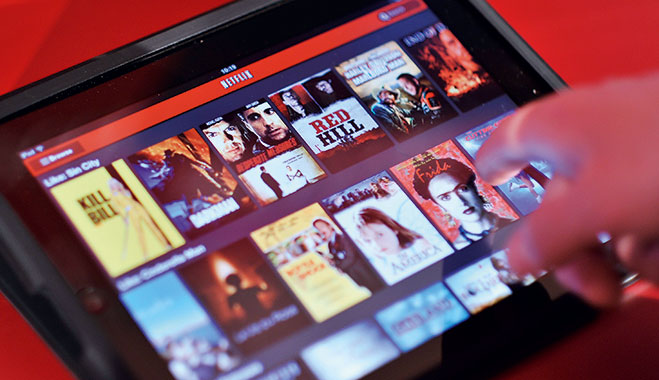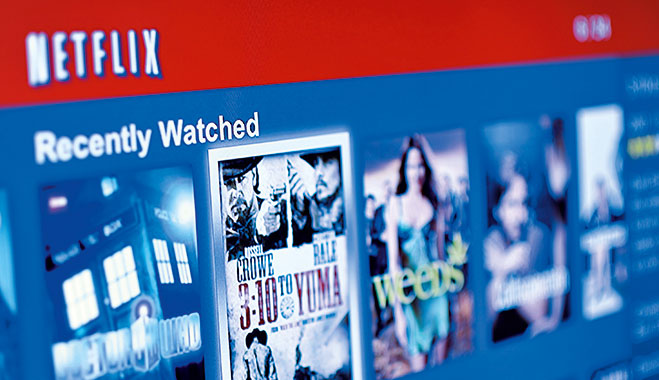Streamers kidnap TV’s viewing audience
The future of television is being shaken up by a digital revolution and a growing number of exciting web-based companies
The future of television is being shaken up by a digital revolution and a growing number of exciting web-based companies

The television industry is one that has been arguably dominated by the same group of providers for much of its existence, but many of these institutions and companies look set to be usurped by an incoming digital revolution fuelled by the desire of consumers to become fully connected and immersed through their TV sets.
Traditionally, studios and broadcasters have controlled the content shown on televisions made by a vast number of consumer electronics manufactures – funding their businesses through advertising or subscription fees. However, with new online entrants into the market who are planning on circumnavigating these traditional forms of broadcasting and aiming to change the way people view their TVs, these old businesses are struggling to maintain their relevance in an ever-interconnected world.
Online services, also known as over-the-top (OTT) content, have grown in recent years as computers and broadband capacity have become more advanced. Companies such as Netflix and Hulu have become steadily popular with people eager to watch what they want, when they want. Elsewhere, telecommunications providers have been eager to tie customers into deals that offer them cable or satellite television and high-speed internet, offering up increased content in order to entice them into long-term contracts.
Advertise this
Many viewers have also found that digital television services like TiVo in the US and Sky+ in the UK have enabled them to skip through adverts, which has caused something of a dilemma in both the advertising industry and the networks that host them. If users can fast forward through adverts, the value of that space is significantly reduced.
While advertising revenue has declined – and this has been mirrored in the amount of money firms are willing to commit to television advertisements – this is thought to be a knock-on result of the uncertain economic climate.
Citibank analysts conducted a study earlier this year that found that despite cable television outperforming total advertising spending in the past two years, this level of performance is not expected to continue. The reasons for this decline could reflect the new ways people are using their televisions, as well as the move towards online forms of video content.
Online advertising spending is expected to continue to grow later in the year, but this may be hampered by new services that offer an ad-free platform in return for a basic, flat subscription fee.
Over-the-top entertainment
Many of the new entrants into the market, including Netflix and Lovefilm, started out as online DVD rental services. Their businesses soon evolved into pure online offerings, as it became clear that the costs of mailing physical films and the infrastructure that it entailed could be slashed as a result of providing a pure streaming service. Instead of relying upon revenues from advertising, some of these new online services require paid subscriptions.
Hulu, a partnership between NBC, Disney and Fox, was set up to provide an outlet for each of those studio’s content online, funded through advertising. It has since grown to offer programmes from other networks, and is a market leader in the US and Japan. The company has seen growth of over 60 percent since 2010, and posted revenues of $420m in 2011.
Amazon has also been eager to get in on the streaming act, with its Amazon Prime service offering an online version of any physical film purchased from Amazon. This is seen as a way to keep physical sales of content flowing, while building up people’s online libraries.
One development that we are likely to see in the future is online streaming companies offering their own content. Hulu started producing its own dramas in 2011, while Netflix has signed deals to bring back cult comedy Arrested Development, which gained a fiercely loyal following when originally broadcast by Fox between 2003 and 2006, but was axed due to low viewing figures. The show’s revival online, expected in 2013, is a sign that streaming companies are able to target specific audiences, without the need to cater for a broader market that is restricted by traditional television schedules.
Netflix now has as many as 27m subscribers around the world, and is expected to grow its business throughout Europe significantly over the coming months, having already launched in the UK and Ireland earlier this year. The company posted hugely impressive revenues in July of $889m, which was much more than many analysts had predicted.
Netflix’s performance over the last year has seen the company make gains in the number of people watching television shows on their service. Nielsen’s data shows an increase of people that preferred to watch TV shows on Netflix had increased by eight percent over the previous year to 19 percent.
Another study conducted by Richard Greenfield of BTIG Research says that Netflix now has more viewers in the US than any other cable television network. After Netflix CEO Reed Hastings said in June that the company had exceeded one billion hours of viewing during that month, Greenfield estimated that would equate to 80 minutes for each user, considerably more than the averages posted by most cable networks.

Cutting the cord
In August it was reported by market research group IHS Screen Digest that the level of subscribers to pay-TV in the US had dropped by almost 350,000 during the second quarter of 2012, which represents the largest fall in the industry’s history. IHS’s analyst Erik Brannon said Netflix was pulling viewers away from traditional pay-TV. “Consumers are spending an increasing amount of time using Netflix at the expense of traditional services like cable and satellite, which may lessen the incentive to retain a pay-TV subscription.”
Telecom companies that offer TV services did see an increase in users however. Brannon said that by offering more services, the telecom industry is hoping to entice viewers to sign up to their full range of packages. “Pay-TV players are betting that by adding extra value for their subscribers – with new offerings like ‘TV Everywhere’, faster internet speeds and deep discounting promotions – they can stem the tide of subscribers defecting to OTT, and entice new ones to join.”
In the UK, BT, traditionally a provider of telephone and internet services, has begun to offer a satellite television service. Initially a basic service that offered much of the content that BskyB offered, BT recently surprised many through its acquisition of the rights to broadcast some Premier League football games from 2013. The deal, which totalled £738m, shows the company is serious about television.
However, some telecom companies don’t believe consumers are quite ready to cut the cord of their cable services and just go online. Comcast CEO Brian Roberts told Bloomberg in August that cable companies are able to offer a wider range of content and that live TV is still relevant to many viewers.
He said: “We provide a breadth of live and catch-up content – what we define as this season’s content, none of which is available in the Netflix rerun world. So from broadcast television to sports to news to the Grammys, the Olympics – all of those pieces of content and thousands of hours per month are not available on Netflix…So with all the press about cord-cutting, facts would say that [Netflix] has really been more additive. There are more multichannel video subscribers today than there » were a year ago. People want more control, more choice, and more personalisation.”

Breaking the habit
Viewing habits have also changed dramatically since the dawn of digital television. Whereas before, people would watch programmes as they were broadcast, enabling advertisers to tailor their spending specifically to viewers – it also meant the adverts had to cater for a wider audience of people that might happen to be watching the particular programme.
There has also been a marked shift in the way that people watch television over recent years. According to a recent report by US ratings firm Nielsen, there has been a sharp decline in the number of people that watched TV in the US at least once a month, from 90 percent in 2010 to 83 percent in 2010. In contrast, the number of people watching some form of video online at least once a month is at 84 percent, surpassing the figure for TV viewers.
Likewise, people are watching less live television than they were before. Research published by Citibank in May showed that there had been a collapse in the number of people watching live cable television in the US, pointing out the rise of services like Netflix as a potential cause for the figures. Citi analyst Jason Bazinet said in a note: “Beginning late last year we began to notice that the aggregate cable network ratings were falling. And, as the months progressed, the magnitude of the decline kept getting larger.”
New sets on the block
Hardware manufacturers are also developing more advanced television sets, with most sold in the last year coming with some form of internet connectivity. According to a report published in July by market intelligence firm Park Associates, the number of people watching online content on their televisions increased by 30 percent in the first six months of the year, while the number of televisions sold with an internet connection has increased from just one percent in 2008 to 45 percent in 2012.
Pietro Macchiarella, an analyst at Park, says the increase in use of these new advanced televisions offer both threats and challenges to the established content providers. “The proliferation of smart TVs and other connected consumer electronics is both an opportunity and a threat for pay-TV providers. They offer the intriguing possibility for the expansion of pay-TV services beyond the set-top box, but they also offer other players such as broadcasters and over-the-top video providers a toehold into the living room.”
Smart TVs provide consumers with another way to access over-the-top services like Netflix on the TV, providing a new distribution channel that all players can leverage to deliver content to consumers. However, by integrating the smart TV into their distribution model, pay-TV providers can leverage their strengths in content costs, customer relationships, bundling, and other areas to play a more substantial role in over-the-top video.”
Ever at the forefront of technological innovation, Apple is expected to make a big leap into the TV market within the next year. Although they have already made tentative steps into the living room with their Apple TV set top box, which allows users to access films and television on their iTunes store as well as streaming content from their computers, this product has for years been described by the company as a “hobby.” This hobby, however, is expected to form a key part of Apple’s next assault on the entertainment space. Having already successfully revolutionised the mobile phone industry and music industry, not to mention its innovation in the traditional computer space, Apple hopes it can have a similar effect on the TV market.
Before his death last year, it was rumoured that Apple founder and then CEO Steve Jobs had plans to revolutionise the TV industry. In Walter Isaacson’s biography, Jobs is reported to have said: “I’d like to create an integrated television set. It would be seamlessly synced with all of your devices and with iCloud. It will have the simplest user interface you could imagine. I finally cracked it.”
As yet, Apple has not launched any meaningful upgrade of its TV service. Although online backups of movies and television shows are provided in users’ iClould storage accounts, there is yet to be any streaming service offered.
Apple’s former CEO John Sculley said in a recent interview with Bloomberg that the company was determined to dominate the TV market, and highlighted their existing range of products as giving them the best chance of succeeding. “They own three screens – the mobile phone, tablet and computer – and you can see how important it is to them to own the fourth, which is TV. People don’t realise how huge this is. Microsoft wanted the living room, Sony wanted the living room, and so far both have failed.”
Google have also looked at the TV market, with the release of set top box in 2010 in partnership with hardware manufacturers Sony and Logitech. However, it did not succeed in cracking the market, and was met with a lukewarm reaction from consumers who found the system confusing and unstable. Other set top box providers include Roku, a US start-up that has recently received $45m investment from Fox’s parent company Newscorp and this year saw its revenue hit $100m, more than double 2011’s figure.
Microsoft has also tried to get in on the act by offering internet TV capabilities on its Xbox gaming system. Sony has also done this with its Playstation 3 games console, which it is trying to position as an entertainment hub.
Firms like Samsung have begun introducing voice and gesture controls into their most advanced television sets, while Apple is expected to employ its Siri voice technology in any smart-TV it launches. Another area that companies are looking at is exploiting multi-screen content. People often watch television while using their laptops, smart phones or tablets to browse the internet. One service that has been set up to help companies harness this connectivity is the NDS Service Delivery Platform, which allows developers to easily create applications that integrate with whatever is being shown on the television.
India’s Digital Direct Broadcast Foundation, a collaboration between seven major Indian technology companies, has been set up to push forward innovations in smart-TVs, with a focus on cloud computing, 14-bit colours, motion enhancement and 3D viewing.
Elsewhere, companies like Germany’s Loewe are showing off advanced television screens that are transparent and incredibly thin, while Samsung are looking at ways to integrate facial recognition software into their televisions.Making the experience more interactive is another area broadcasters are looking at as a means to engage with their dwindling audiences. Services like Twitter seem to be integrated into many programmes, with viewers encouraged to interact with one another through hashtags.
The scramble to get in on the act of the online TV market was anticipated in the UK by terrestrial broadcasters such as the BBC and ITV. While the BBC has led the way in delivering a successful online catch-up service with its iPlayer – with rival channels ITV and Channel 4 also following in its footsteps – communications companies British Telecom and Arqiva have found it much harder to sustain. The YouView service that spawned from this collaboration was originally announced in 2010, but after a series of delays and complaints from commercial rivals like Sky, the service eventually launched two years later in July of this year.
Some of these innovations seem like unnecessary gimmicks, and may point to an alarming trend in television manufacturers adding services to their sets that may seem exciting and new, but are ultimately pointless. The average viewer is unlikely to want to pay excessive fees for services like voice and facial recognition if they aren’t likely to ever use the features beyond the first few days of trying them out.
How the television industry looks in the future will depend a lot on how traditional networks manage the influx of new entrants into the market. If they are able to hold onto the content development side of their business, the advertising spending will remain. These companies are also looking to innovate, with Newscorp’s backing of services like Roku, and other studios putting money into Hulu, signs that they are eager to gain significant footholds in the world of digital television.













